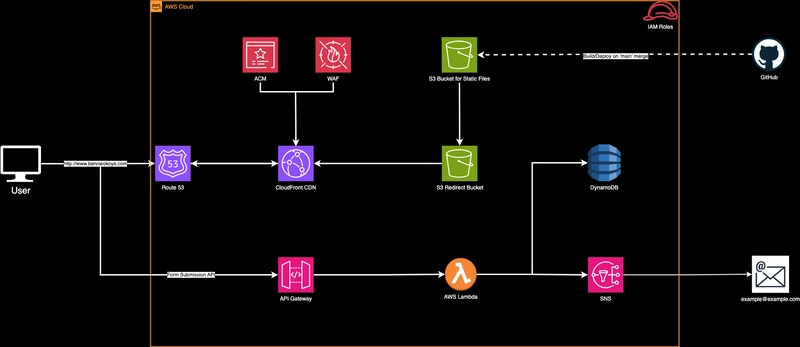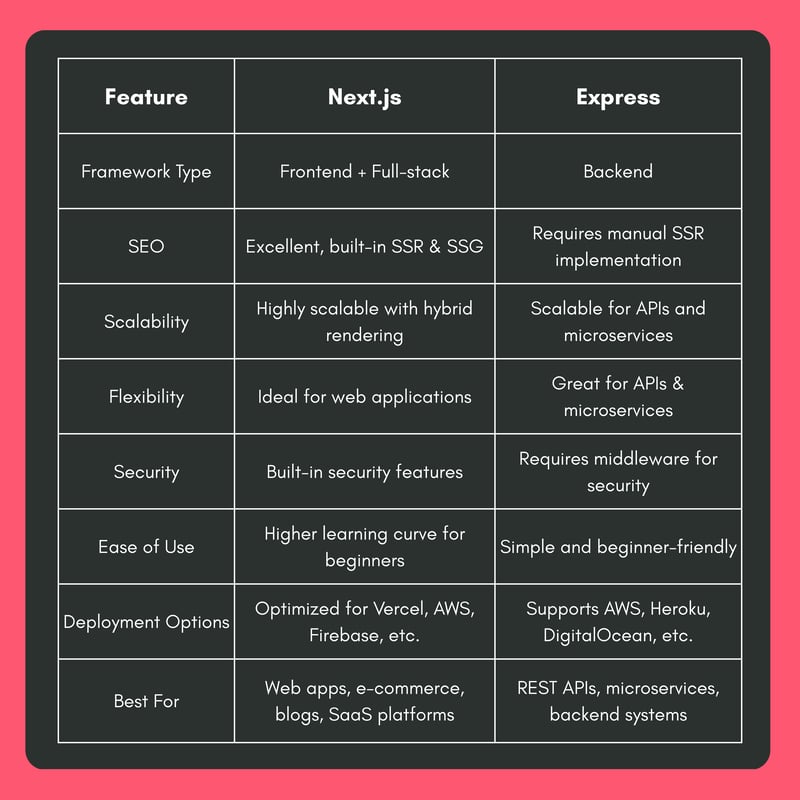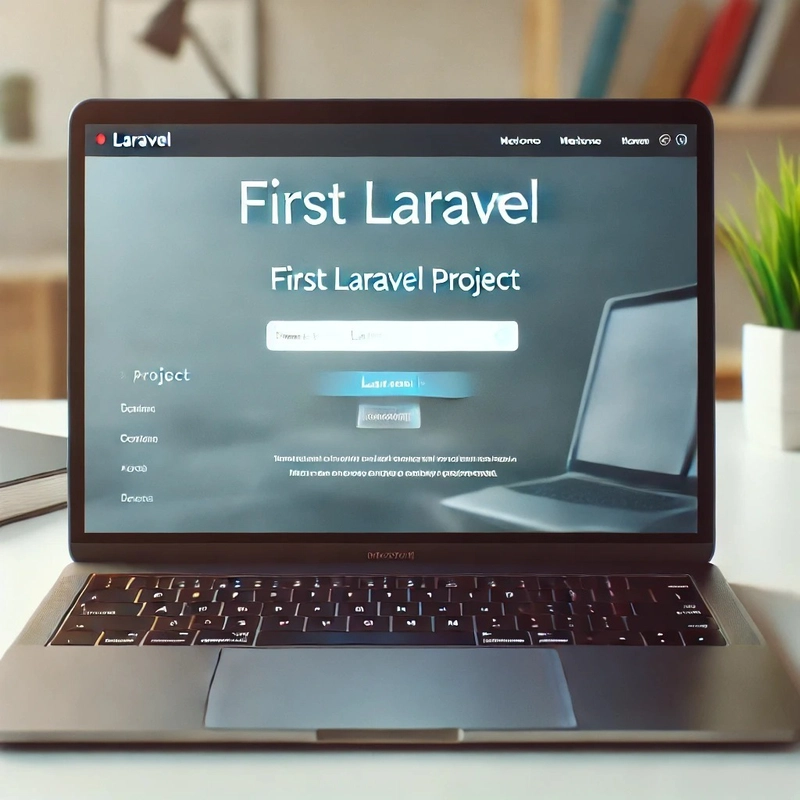Host Your Web App For Free Using AWS Serverless Architecture + CB Credits
My website www.bennwokoye.com runs on AWS serverless architecture at almost zero cost. Continue for insights and pros of deploying it entirely using AWS serverless resources. You can leverage this architecture to host your web applications, as AWS CB credits can be applied towards resource costs. Architecture Diagram Overview of the Architecture The core components of my architecture leveraging AWS serverless solutions: Static content hosting: Amazon S3 Domain and DNS management: Route 53 Content Delivery Network (CDN): CloudFront Backend processing: API Gateway, Lambda, SNS, DynamoDB Security and SSL: AWS WAF, AWS Certificate Manager (ACM) CI/CD automation: GitHub + GitHub Actions Infrastructure as Code: Terraform Static Content Hosting with Amazon S3 I choose AWS S3 to host HTML, CSS, and JavaScript files. S3 provides an easy, cost-effective, and scalable solution for static web hosting. Amazon S3's high availability ensures reliable content accessibility from anywhere globally. Domain Management and DNS with Route 53 AWS Route 53 handles domain registration and translates my domain name into IP addresses, making DNS management straightforward and reliable. It also offers health checks and failover support to maintain high availability. CDN and Caching with AWS CloudFront AWS CloudFront caches my content at edge locations globally, significantly reducing load times and latency for global users. It integrates seamlessly with S3 as the origin and automatically invalidates caches whenever new content is deployed through my CICD pipeline, ensuring visitors always see the latest version of my website. Enhanced Security with WAF and ACM AWS Web Application Firewall (WAF) is integrated with CloudFront to protect my site against common web exploits and attacks. AWS Certificate Manager (ACM) provides free, automated SSL certificates, ensuring encrypted and secure connections to my site. Serverless Backend: API Gateway, AWS Lambda, SNS & DynamoDB I leveraged API Gateway to expose a secure REST API to handle dynamic interactions with my contact form submissions, triggering an AWS Lambda function to process requests. This eliminates server management overhead and allows automatic scaling based on traffic. Notifications with Amazon SNS I integrated Amazon SNS with the Lambda function to send notifications whenever a user submits a form. SNS sends email notifications instantly, informing me promptly of user interactions without manual checks. Data Storage with DynamoDB I also store messages submitted via the contact form in Amazon DynamoDB, a highly performant, serverless NoSQL database. DynamoDB ensures scalable, secure, and reliable storage for user-generated data. Automated CI/CD with GitHub + GitHub Actions The entire deployment process is automated using GitHub + GitHub actions. A commit to the main branch of my GitHub repository triggers an automatic deployment, ensuring fast, consistent updates. The pipeline automatically fetches, builds, deploys, and invalidates CloudFront cache, streamlining updates effortlessly. Infrastructure Management via Terraform All resources are managed through Terraform, enabling version control, modularity, and reusability. Why Serverless? This architecture offers significant advantages: Cost Efficiency: No infrastructure management overhead, pay only for resources used. High Availability: 99.99% uptime with auto-scaling. Security: Integrated AWS security, DDoS protection, and request throttling. Performance: Minimized latency with a global CDN. Automation: Streamlined updates via automated CI/CD pipelines. Adopting AWS serverless services accelerated the time and effort to build a cost-effective, scalable, secure web app following well-architected framework and industry best practices. This approach simplifies operations and provides a solid foundation for autoscaling and integration with other AWS serverless offerings. Follow me on LinkedIn to explore opportunities for collaboration and innovation. Let's build something great together, for now and the future.

My website www.bennwokoye.com runs on AWS serverless architecture at almost zero cost. Continue for insights and pros of deploying it entirely using AWS serverless resources. You can leverage this architecture to host your web applications, as AWS CB credits can be applied towards resource costs.
Architecture Diagram
Overview of the Architecture
The core components of my architecture leveraging AWS serverless solutions:
- Static content hosting: Amazon S3
- Domain and DNS management: Route 53
- Content Delivery Network (CDN): CloudFront
- Backend processing: API Gateway, Lambda, SNS, DynamoDB
- Security and SSL: AWS WAF, AWS Certificate Manager (ACM)
- CI/CD automation: GitHub + GitHub Actions
- Infrastructure as Code: Terraform
Static Content Hosting with Amazon S3
I choose AWS S3 to host HTML, CSS, and JavaScript files. S3 provides an easy, cost-effective, and scalable solution for static web hosting. Amazon S3's high availability ensures reliable content accessibility from anywhere globally.
Domain Management and DNS with Route 53
AWS Route 53 handles domain registration and translates my domain name into IP addresses, making DNS management straightforward and reliable. It also offers health checks and failover support to maintain high availability.
CDN and Caching with AWS CloudFront
AWS CloudFront caches my content at edge locations globally, significantly reducing load times and latency for global users. It integrates seamlessly with S3 as the origin and automatically invalidates caches whenever new content is deployed through my CICD pipeline, ensuring visitors always see the latest version of my website.
Enhanced Security with WAF and ACM
AWS Web Application Firewall (WAF) is integrated with CloudFront to protect my site against common web exploits and attacks. AWS Certificate Manager (ACM) provides free, automated SSL certificates, ensuring encrypted and secure connections to my site.
Serverless Backend: API Gateway, AWS Lambda, SNS & DynamoDB
I leveraged API Gateway to expose a secure REST API to handle dynamic interactions with my contact form submissions, triggering an AWS Lambda function to process requests. This eliminates server management overhead and allows automatic scaling based on traffic.
Notifications with Amazon SNS
I integrated Amazon SNS with the Lambda function to send notifications whenever a user submits a form. SNS sends email notifications instantly, informing me promptly of user interactions without manual checks.
Data Storage with DynamoDB
I also store messages submitted via the contact form in Amazon DynamoDB, a highly performant, serverless NoSQL database. DynamoDB ensures scalable, secure, and reliable storage for user-generated data.
Automated CI/CD with GitHub + GitHub Actions
The entire deployment process is automated using GitHub + GitHub actions. A commit to the main branch of my GitHub repository triggers an automatic deployment, ensuring fast, consistent updates. The pipeline automatically fetches, builds, deploys, and invalidates CloudFront cache, streamlining updates effortlessly.
Infrastructure Management via Terraform
All resources are managed through Terraform, enabling version control, modularity, and reusability.
Why Serverless?
This architecture offers significant advantages:
- Cost Efficiency: No infrastructure management overhead, pay only for resources used.
- High Availability: 99.99% uptime with auto-scaling.
- Security: Integrated AWS security, DDoS protection, and request throttling.
- Performance: Minimized latency with a global CDN.
- Automation: Streamlined updates via automated CI/CD pipelines.
Adopting AWS serverless services accelerated the time and effort to build a cost-effective, scalable, secure web app following well-architected framework and industry best practices. This approach simplifies operations and provides a solid foundation for autoscaling and integration with other AWS serverless offerings.
Follow me on LinkedIn to explore opportunities for collaboration and innovation. Let's build something great together, for now and the future.








































































































































































![[The AI Show Episode 142]: ChatGPT’s New Image Generator, Studio Ghibli Craze and Backlash, Gemini 2.5, OpenAI Academy, 4o Updates, Vibe Marketing & xAI Acquires X](https://www.marketingaiinstitute.com/hubfs/ep%20142%20cover.png)































































































































![From drop-out to software architect with Jason Lengstorf [Podcast #167]](https://cdn.hashnode.com/res/hashnode/image/upload/v1743796461357/f3d19cd7-e6f5-4d7c-8bfc-eb974bc8da68.png?#)





























































































![Switch 2 Pre-Order Rules Are Some BS: Here's How They Work [Update]](https://i.kinja-img.com/image/upload/c_fill,h_675,pg_1,q_80,w_1200/485ec87fd3cea832387b2699e4cbd2a1.jpg)











.png?#)




(1).jpg?width=1920&height=1920&fit=bounds&quality=80&format=jpg&auto=webp#)




-Mario-Kart-World-Hands-On-Preview-Is-It-Good-00-08-36.jpg?width=1920&height=1920&fit=bounds&quality=80&format=jpg&auto=webp#)





















_NicoElNino_Alamy.png?#)
_Igor_Mojzes_Alamy.jpg?#)

.webp?#)
.webp?#)













































































































![Blackmagic Design Unveils DaVinci Resolve 20 With Over 100 New Features and AI Tools [Video]](https://www.iclarified.com/images/news/96951/96951/96951-640.jpg)


![Apple Considers Delaying Smart Home Hub Until 2026 [Gurman]](https://www.iclarified.com/images/news/96946/96946/96946-640.jpg)






























































































































